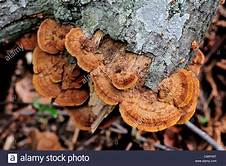Written by Robert Korpella and published on https://homeguides.sfgate.com/
Mushrooms are a common sight in fertile garden soil, healthy landscapes, on outdoor woodpiles, and fallen trees. This may contribute to the misplaced sense of normalcy when you see them growing on tree trunks or root flares.
When you have mushrooms growing in your yard or at the base of your tree it can be worrisome. Mushrooms can be a sign of root rot, heart rot, and overall decay. When these conditions are left untreated it can cause your tree to uproot or snap and come crashing down on your property.
Although not all mushrooms are bad, it’s important to be able to recognize mushrooms that are signs of decay.
Mushrooms & Dying Trees
Mushrooms on a tree are an indication the tree is suffering damage. The tree may be dying, or at least facing serious health issues. Mushrooms are the fruiting body of a fungus, and they often sprout after the fungus has already established itself inside the tree. By the time mushrooms form, the internal structure of the tree is usually already compromised.
Fungal Attacks
Some types of fungi attack tree roots directly, while others enter the tree through a wound. Cuts and scrapes in bark or roots open a tree to fungal attacks. These wounds may have come from a nick by a lawn mower blade, excavations, pruning, or from wind and ice damage. Once the fungus finds a way into the tree’s interior tissue, it produces an enzyme that breaks down wood fibers, releasing nutrients needed to feed the fungus. After mushrooms become visible, the attack is well underway, and the fungus has begun reproducing through spores in or on the mushroom.
Symptoms
Some symptoms of a fungal attack may be easy to miss if you don’t see mushrooms. Dying leaves and limbs, bark discoloration, early fall colors and lesions may resemble symptoms of other diseases. Mushrooms may only last a few days or weeks, depending on the species, so they will not always be present. Mushrooms may appear along the roots, trunk, one or more limbs, or at pruned sites on the tree. If you see mushrooms, it’s an indication of extensive interior damage to roots, branches or the trunk.
Damage
As the fungus eats away at the tree’s tissues, it destroys the entire structure. Root damage could result in trees that topple in a high wind. Branch and trunk damage results in weakened limbs that break off, their falling putting people and property in danger. Some of these issues may arise before mushrooms appear, and they are likely to occur after mushrooms arrive.
What to Do
Once a tree is infected by a fungus and mushrooms appear, there is little, if anything, you can do to save the tree. You may wish to call a certified arborist, a professional trained in diagnosing and recommending treatment for various tree diseases. Occasionally, if the infected limb is removed, you can save the tree, but the more likely scenario is that the tree must be completely removed. The fungus and spores may also live in the soil, proving fatal to other trees or shrubs planted in the same spot. An arborist may suggest methods to expedite the process of removing fungi from soil.
Original post here https://homeguides.sfgate.com/mushrooms-dying-trees-66164.html


